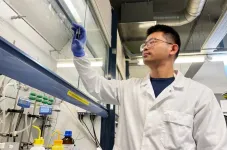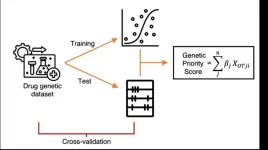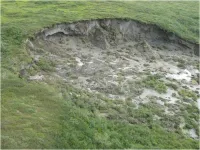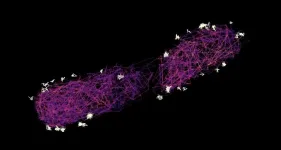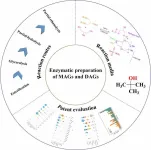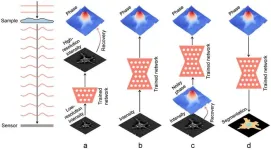What makes urine yellow? UMD scientists discover the enzyme responsible
Their findings could be applied to future studies of gut health, including conditions like jaundice and inflammatory bowel disease
2024-01-03
(Press-News.org)
Researchers at the University of Maryland and National Institutes of Health have identified the microbial enzyme responsible for giving urine its yellow hue, according to a new study published in the journal Nature Microbiology on January 3, 2024.
The discovery of this enzyme, called bilirubin reductase, paves the way for further research into the gut microbiome’s role in ailments like jaundice and inflammatory bowel disease.
“This enzyme discovery finally unravels the mystery behind urine’s yellow color,” said the study’s lead author Brantley Hall, an assistant professor in the University of Maryland’s Department of Cell Biology and Molecular Genetics. “It’s remarkable that an everyday biological phenomenon went unexplained for so long, and our team is excited to be able to explain it.”
When red blood cells degrade after their six-month lifespan, a bright orange pigment called bilirubin is produced as a byproduct. Bilirubin is typically secreted into the gut, where it is destined for excretion but can also be partially reabsorbed. Excess reabsorption can lead to a buildup of bilirubin in the blood and can cause jaundice—a condition that leads to the yellowing of the skin and eyes. Once in the gut, the resident flora can convert bilirubin into other molecules.
“Gut microbes encode the enzyme bilirubin reductase that converts bilirubin into a colorless byproduct called urobilinogen,” explained Hall, who has a joint appointment in the University of Maryland Institute for Advanced Computer Studies. “Urobilinogen then spontaneously degrades into a molecule called urobilin, which is responsible for the yellow color we are all familiar with.”
Urobilin has long been linked to urine’s yellow hue, but the research team’s discovery of the enzyme responsible answers a question that has eluded scientists for over a century.
Aside from solving a scientific mystery, these findings could have important health implications. The research team found that bilirubin reductase is present in almost all healthy adults but is often missing from newborns and individuals with inflammatory bowel disease. They hypothesize that the absence of bilirubin reductase may contribute to infant jaundice and the formation of pigmented gallstones.
“Now that we’ve identified this enzyme, we can start investigating how the bacteria in our gut impact circulating bilirubin levels and related health conditions like jaundice,” said study co-author and NIH Investigator Xiaofang Jiang. “This discovery lays the foundation for understanding the gut-liver axis.”
In addition to jaundice and inflammatory bowel disease, the gut microbiome has been linked to various diseases and conditions, from allergies to arthritis to psoriasis. This latest discovery brings researchers closer to achieving a holistic understanding of the gut microbiome’s role in human health.
“The multidisciplinary approach we were able to implement—thanks to the collaboration between our labs—was key to solving the physiological puzzle of why our urine appears yellow,” Hall said. “It’s the culmination of many years of work by our team and highlights yet another reason why our gut microbiome is so vital to human health.”
###
This article was adapted from text provided by Brantley Hall and Sophia Levy.
In addition to Hall, UMD-affiliated co-authors included Stephenie Abeysinghe (B.S. ’23, public health science); Domenick Braccia (Ph.D. ’22, biological sciences); biological sciences major Maggie Grant; biochemistry Ph.D. student Conor Jenkins; biological sciences Ph.D. students Gabriela Arp (B.S. ’19, public health science; B.A. ’19, Spanish language), Madison Jermain, Sophia Levy (B.S. ’19, chemical engineering; B.S. ’19, biological sciences) and Chih Hao Wu (B.S. ’21, biological sciences); Glory Minabou Ndjite (B.S. ’22, public health science); and Ashley Weiss (B.S. ’22, biological sciences).
Their paper, “Discovery of a gut microbial enzyme that reduces bilirubin to urobilinogen,” was published in the journal Nature Microbiology on January 3, 2024.
This research was supported by the NIH’s Intramural Research Program, the National Library of Medicine and startup funding from UMD. This article does not necessarily reflect the views of these organizations.
END
ELSE PRESS RELEASES FROM THIS DATE:
2024-01-03
Invisible to our eyes, shortwave infrared (SWIR) light can enable unprecedented reliability, function and performance in high-volume, computer vision first applications in service robotics, automotive and consumer electronics markets. Image sensors with SWIR sensitivity can operate reliably under adverse conditions such as bright sunlight, fog, haze and smoke. Furthermore, the SWIR range provides eye-safe illumination sources and opens up the possibility of detecting material properties through molecular imaging.
Colloidal quantum ...
2024-01-03
CAMBRIDGE, MA -- With help from an artificial language network, MIT neuroscientists have discovered what kind of sentences are most likely to fire up the brain’s key language processing centers.
The new study reveals that sentences that are more complex, either because of unusual grammar or unexpected meaning, generate stronger responses in these language processing centers. Sentences that are very straightforward barely engage these regions, and nonsensical sequences of words don’t do much for them either.
For ...
2024-01-03
New York, NY [January 3, 2024]—Driven by the need for a better way to prioritize targets for drug development, the Icahn School of Medicine at Mount Sinai has led the development of a novel “genetic priority score” (GPS) that will integrate various types of human genetic data into a single easy-to-interpret score.
The findings were described in the January 3 online issue of Nature Genetics [DOI: 10.1038/s41588-023-01609-2].
Studies have shown that drugs have an increased likelihood of success in clinical trials when ...
2024-01-03
Alaska is on the front lines of climate change, experiencing some of the fastest rates of warming of any place in the world. And when temperatures rise in the state’s interior—a vast high-latitude region spanning 113 million acres—permafrost there not only thaws, releasing significant amounts of its stored carbon back into the atmosphere where it further accelerates rising temperatures, but it decays. This decomposition has the potential to infuse above- and belowground food webs with carbon, which can affect ...
2024-01-03
Disease-causing bacteria of the genus Salmonella or Yersinia can use tiny injection apparatuses to inject harmful proteins into host cells, much to the discomfort of the infected person. However, it is not only with a view to controlling disease that researchers are investigating the injection mechanism of these so-called type III secretion systems, also known as "injectisomes".
If the structure and function of the injectisome were fully understood, researchers would be able to hijack it to deliver specific drugs into cells, such as cancer cells. In fact, the structure of the injectisome has already been elucidated. ...
2024-01-03
MAGs, predominantly in 1(3)-MAG form, and DAGs, with 1,3-DAGs as the more stable isomer, are crucial in food, cosmetic, and other industries. While MAGs are vital emulsifiers, comprising 75% of global production, DAGs are known as functional cooking oils that can reduce body fat and serum TAGs. However, their natural concentration in oils is low, prompting extensive research into their chemical and environmentally-friendly enzymatic production.
Recently, a review published in the Grain & Oil Science and Technology journal on 2 November 2023, has shed light on the advancements in enzymatic production methods with special efforts on practical and ...
2024-01-03
In Hawaiʻi and across much of Oceania, Pacific Islanders celebrate the connections between their islands and the ocean that surrounds them. “As descendants of the ocean, the dearth of Native Hawaiians and Pacific Islanders (NHPI) in ocean science seems inconsonant,” writes a team of authors that includes University of Hawai‘i (UH) at Mānoa faculty, students, and alumni in an article in a special issue of the journal Oceanography, “Building Diversity, Equity, and Inclusion in the Ocean Sciences. The authors ask, “Where are all our island people in the ...
2024-01-03
In China, national parks represent the country’s most unique natural landscapes. Scientific evaluation of landscape resources is significant for preserving the authenticity and integrity of national parks. Taking Qianjiangyuan National Park System Pilot Zone as an example, this research investigated the willingness of internal group (residents and administrative staff) and external group (tourists) to pay for a hypothetical market project based on the pilot zone via Contingent Valuation Method to acquire the monetized value of landscape resources in the national park, and applied Logistic Regression to analyze the influencing factors. The results show ...
2024-01-03
In 2022, the insurance industry made a whopping USD 6 trillion globally—more than the entire economy of big countries like Japan and Germany. A new study, published in The Journal of Finance and Data Science, looked at how technology, especially big data, is shaking things up in insurance. Big data means using a lot of information to make better decisions.
The study found that by using big data, insurance companies can understand risks better, offer fair prices and keep customers happier.
“What's surprising is how fast insurance companies are jumping on the big data bandwagon,” says first ...
2024-01-03
Light, as an electromagnetic field, has two essential components: amplitude and phase. However, optical detectors, usually relying on photon-to-electron conversion (such as charge-coupled device sensors and the human eye), cannot capture the phase of the light field because of their limited sampling frequency. Fortunately, as the light field propagates, the phase delay also causes changes in the amplitude distribution; therefore, we can record the amplitude of the propagated light field and then calculate the corresponding phase, called phase recovery. Some common phase ...
LAST 30 PRESS RELEASES:
[Press-News.org] What makes urine yellow? UMD scientists discover the enzyme responsible
Their findings could be applied to future studies of gut health, including conditions like jaundice and inflammatory bowel disease
